Madrid’s history was shaped inside royal courts, Jesuit schools, and Moorish fortresses. The city became a capital in the 16th century, but its foundations go deeper, beneath cathedrals built on former mosques and palaces raised where past kings once ruled in silence. The historical places in Madrid reflect every shift from the Bourbon dynasty to civil unrest, from imperial power to modern democracy. At Puerta del Sol, uprisings began. In El Escorial, kings are still buried. The past was never cleared away here, it was built over, layered, and kept alive.
Top Historical Places In Madrid
These eleven historical places in Madrid show how the city evolved through power and revolt, each one holding a chapter of Spain’s long past.
1. Royal Palace Of Madrid
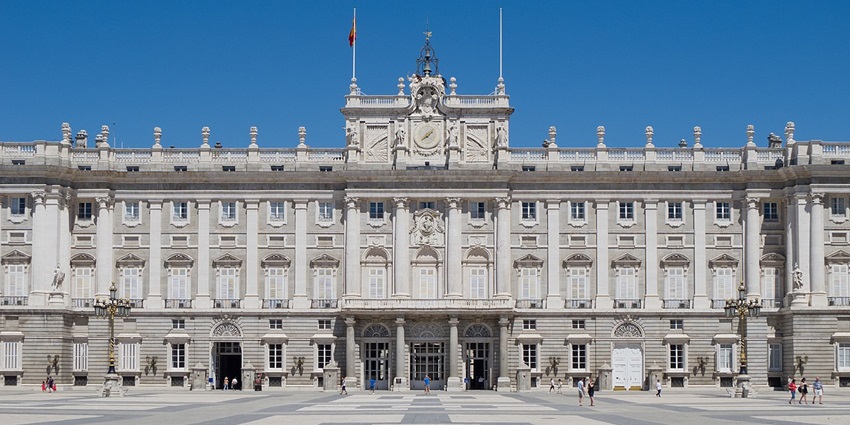
Photo: Carlos Delgado / Wikimedia Commons
This is one of the most defining historical places in Madrid. It was built entirely from stone and brick, avoiding wood after the devastating fire. Its design came from a mix of French influence and Italian detailing, especially in its symmetry and ornamentation. Inside, there are more than 3,000 rooms, but only a small portion is open to visitors. The rooms include the Throne Room with its crimson velvet walls, the Hall of Columns once used for royal balls, and the Royal Chapel with its carved dome. Though no longer a residence, the palace is still used for official state events and royal ceremonies.
How To Reach: Metro Ópera (Lines 2, 5, R)
Cost: €12; free entry on select days for EU residents
Timings: 10 AM – 6 PM (Oct-Mar), 10 AM – 7 PM (Apr-Sep)
Nearby Attractions: Almudena Cathedral, Sabatini Gardens, Campo del Moro
2. Almudena Cathedral (Catedral De Santa María La Real De La Almudena)
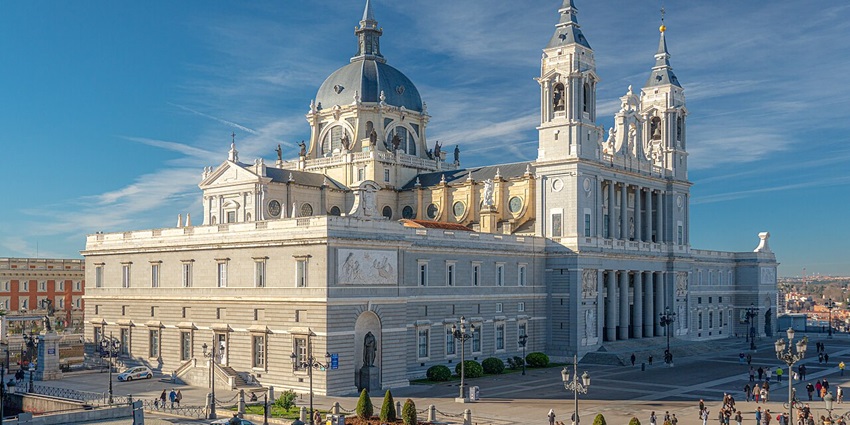
Photo: Fernando / Wikimedia Commons
Few historical places in Madrid have taken as long to complete as the Almudena Cathedral. Construction began in 1883, but the final consecration only happened in 1993, carried out by Pope John Paul II. The site where it stands once held a medieval mosque and later a church dedicated to the Virgin of Almudena, Madrid’s patroness. The long construction led to a blend of styles with its exterior mirroring the neoclassical look of the neighbouring Royal Palace, while the inside reflects a mix of neo-Gothic and Romanesque forms.
How To Reach: Metro Ópera (Lines 2, 5)
Cost: Museum and dome €7
Timings: 9 AM – 8.30 PM
Nearby Attractions: Royal Palace, Plaza de Oriente
3. Plaza Mayor

Photo: Carlos Delgado / Wikimedia Commons
Plaza Mayor began as a simple market square just outside Madrid’s old city walls. In the early 1600s, King Philip III ordered it to be rebuilt in stone after a series of fires. The bronze statue of Philip III stands at the centre, facing the spot where events like trials, executions, and festivals once took place. One side of the square holds Casa de la Panadería, a building with royal connections and, later, the seat of the city’s cultural offices. Its painted façade was added much later, in the 1990s, to reflect stories from Madrid’s past.
How To Reach: Metro Sol (Lines 1, 2, 3) or La Latina (Line 5)
Timings:24*7
Nearby Attractions: Mercado de San Miguel, Casa de la Panadería, Calle Mayor
4. Puerta Del Sol
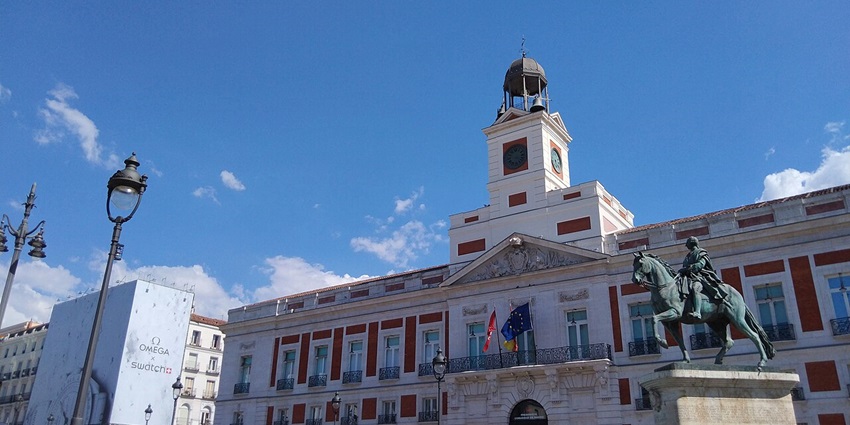
Photo: Artistosteles / Wikimedia Commons
Puerta del Sol is more than a busy intersection; it is where Madrid’s history has often taken a turn. The clock above the Real Casa de Correos strikes midnight on New Year’s Eve, marking Spain’s most-watched tradition, the twelve-grape countdown. Just a few steps away stands the plaque marking Kilometre Zero, the spot from which all major roads in Spain are measured. You will also find a bronze statue, a symbol tied closely to Madrid’s identity. Among all historical places in Madrid, Puerta del Sol remains the most connected to daily life, an open, public space where the city still gathers.
How To Reach: Metro Sol (Lines 1, 2, 3) or Cercanías Sol station
Timings: 24*7
Nearby attractions: Gran Vía, Calle Mayor, El Oso y el Madroño statue
5. Templo De Debod
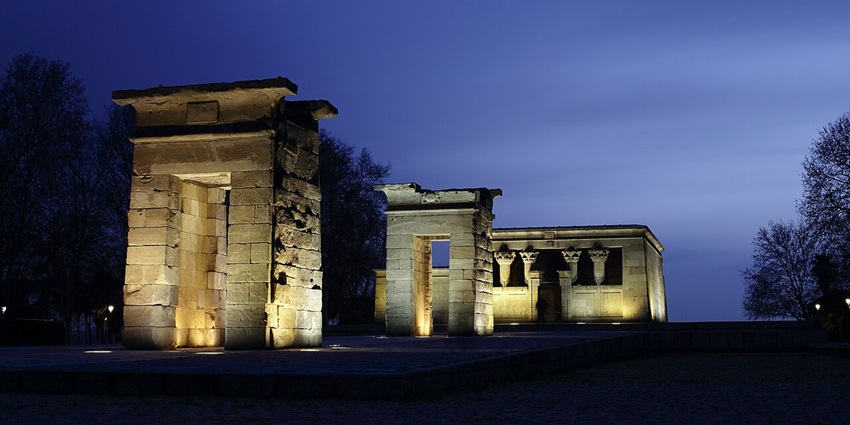
Photo: Javier Perez Montes / Wikimedia Commons
Templo de Debod is one of the few ancient Egyptian monuments located outside Egypt, and the only one in Spain. It arrived in Madrid in the late 1960s as a gift from the Egyptian government, in recognition of Spain’s help in saving temples threatened by the construction of the Aswan Dam. The structure dates back to the 2nd century BCE and was originally built near Aswan, dedicated to the gods Amun and Isis. While it is no longer in its original context, the temple still carries carvings, hieroglyphs, and chambers that connect visitors to a civilisation far from Madrid’s history.
How To Reach: Metro Plaza de España (Lines 3, 10)
Timings: 10 AM – 8 PM; closed on Mondays
Nearby attractions: Parque del Oeste, Mirador de la Montaña, Royal Palace
6. San Isidro Museum
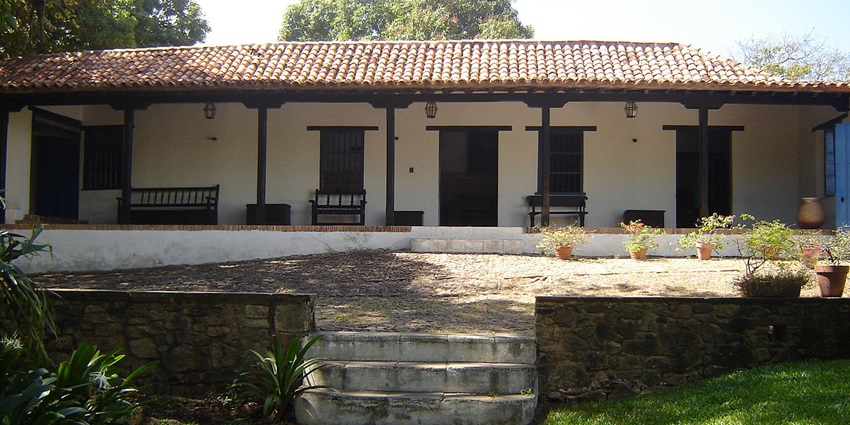
Photo: Guillermo Ramos Flamerich/ Wikimedia Commons
This museum is dedicated to Madrid’s patron saint, San Isidro Labrador, and sits on a site believed to be where he once lived with his wife, Santa María de la Cabeza. The building itself is from the 16th century and was formerly the Palace of the Marquis of Paredes. Inside, you will find Roman mosaics, Islamic pottery, and medieval artefacts discovered in and around the city. One of the most visited features is the well where San Isidro is said to have performed a miracle, rescuing his son after he fell in.
How To Reach: Metro La Latina (Line 5)
Timings: 10 AM – 8 PM; closed on Mondays
Nearby Attractions: Plaza de Cascorro, El Rastro, Basilica of San Francisco
7. Royal Basilica Of San Francisco El Grande
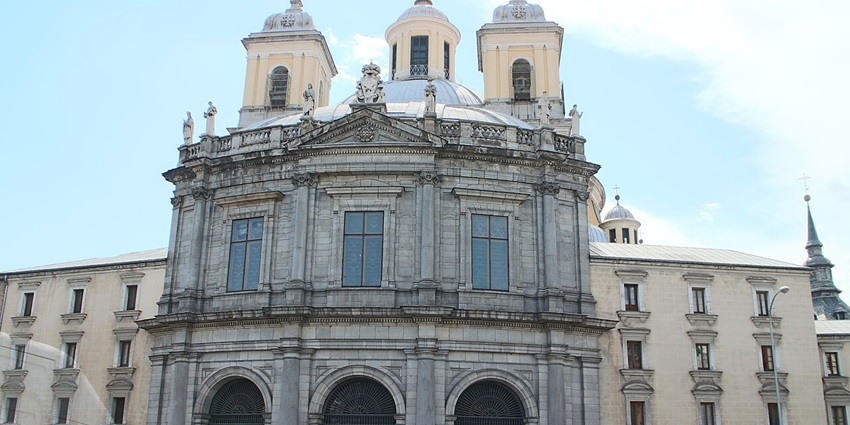
Photo: Suicasmo / Wikimedia Commons
This basilica was built in the late 1700s on land once occupied by a Franciscan convent, said to have been visited by Saint Francis himself in the 13th century. The structure is circular in plan, topped by a dome that remains one of the largest in all of Europe. From the outside, the building looks restrained, but the interior is lined with chapels, gilded altars, and large oil paintings. One of these, in the Chapel of San Bernardino, was painted by Francisco de Goya. That piece alone draws visitors who are interested in Spain’s artistic history.
How To Reach: Metro La Latina (Line 5)
Cost: €5
Timings: 10:30 AM – 12:30 PM and 4 PM – 6:30 PM (Tue–Sat)
Nearby Attractions: Segovia Bridge, Campo del Moro Gardens
8. Puerta De Alcalá
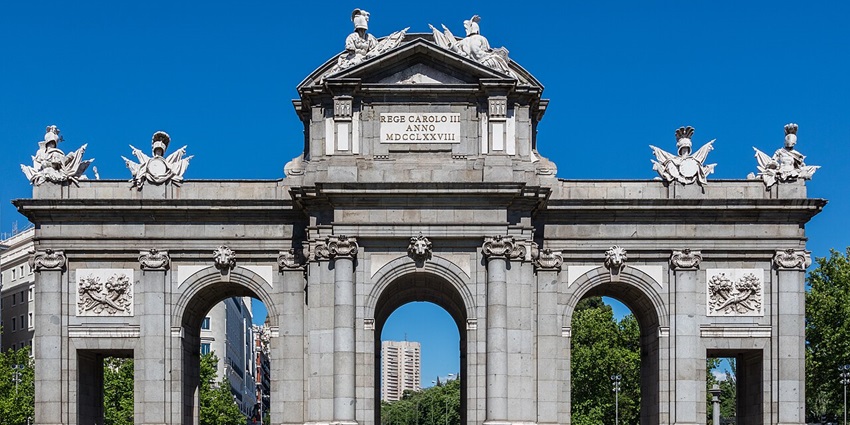
Photo: Diego Delso / Wikimedia Commons
Built in 1778 under the orders of King Charles III, Puerta de Alcalá was one of the original five royal gates that once marked the entry into Madrid. It was designed by Francesco Sabatini, an Italian architect closely linked to many royal projects during that period. Made from granite and limestone, its design features five openings, Corinthian columns, and sculpted lions and angels. Each side of the gate is slightly different, a detail often missed by casual visitors. Though it no longer serves as an entrance, Puerta de Alcalá remains one of the most visible historical places in Madrid.
How To Reach: Metro Retiro (Line 2) or Banco de España (Line 2)
Timings: 24*7
Nearby Attractions: Retiro Park, Cibeles Fountain, National Archaeological Museum
9. Palacio De Cristal (Crystal Palace)
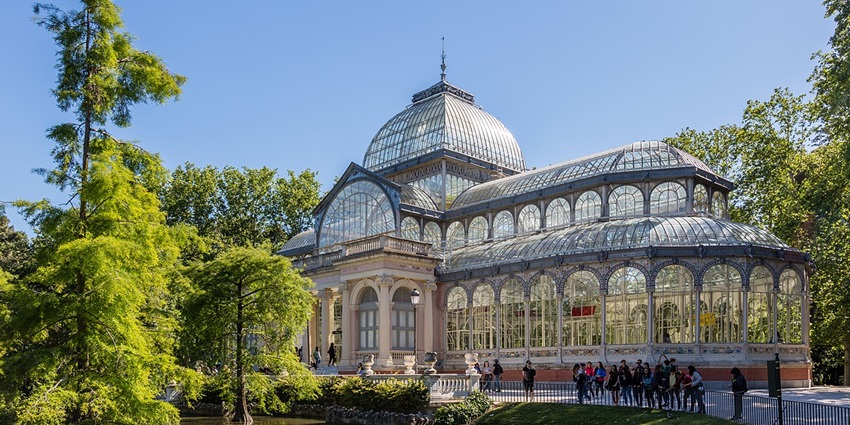
Photo: Diego Delso / Wikimedia Commons
Palacio de Cristal was completed in 1887 inside Retiro Park to house an exhibition of plants brought from the Philippines, which was then a Spanish colony. The exhibition was part of Spain’s broader effort to show its overseas presence through public displays in the capital. The building was placed beside a small lake, and its design included a high central dome and a layout shaped like a cross. Though it no longer holds botanical displays, it now hosts temporary art installations curated by the Reina Sofía Museum.
How To Reach: Metro Retiro (Line 2)
Timings: 10 AM – 10 PM; closed on some holidays
Nearby Attractions: Retiro Park, Palacio de Velázquez, Estanque Grande del Retiro
10. El Escorial
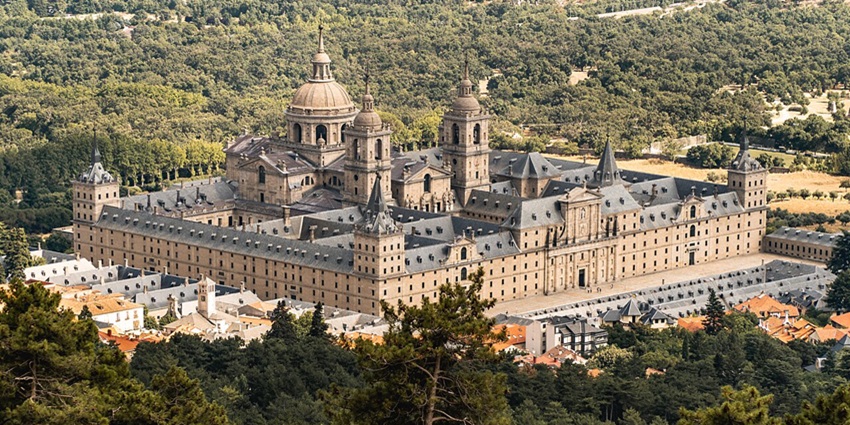
Photo: Zvonimir Stamenov / Wikimedia Commons
El Escorial was ordered by King Philip II and built during the second half of the 1500s. It was designed to be more than a royal residence. It served as a monastery, a royal burial place, a library, and a symbol of Spanish authority. Work began under Juan Bautista de Toledo and was completed by Juan de Herrera, who gave the building its severe, geometric look. The complex includes a basilica, royal apartments, a grand library, and the Royal Pantheon, where most Spanish monarchs are buried. The walls are bare and heavy, built in stone without decoration.
How To Reach: Cercanías C-3 to El Escorial station, then 15 minutes on foot
Cost: €12
Timings: 10 AM – 6 PM (Tue–Sun)
Nearby Attractions: Casita del Infante, Valle de los Caídos
11. Cervantes Birthplace Museum (Museo Casa Natal De Cervantes)
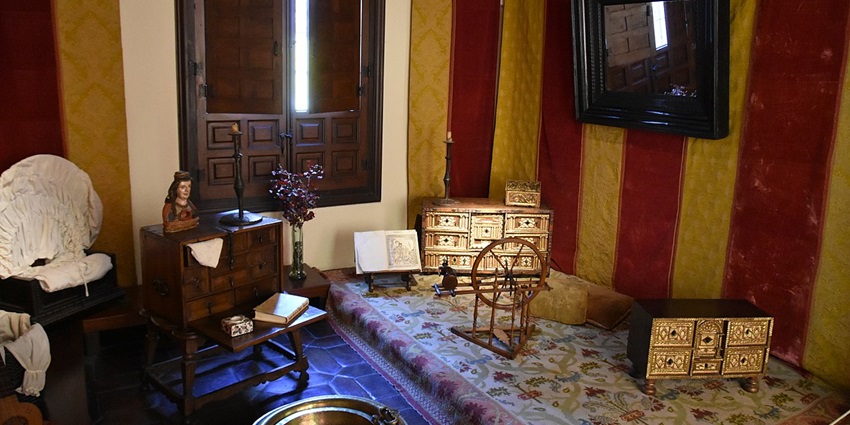
Photo: Richard Mortel / Wikimedia Commons
This house stands on Calle Mayor in Alcalá de Henares and is believed to be where Miguel de Cervantes was born in 1547. The building is a well-preserved example of a Castilian home from the 16th century, with two floors arranged around a central courtyard. Inside, rooms have been furnished with period pieces to reflect how a family of modest means would have lived at the time. The ground floor contains spaces used for daily life, a kitchen, a dining area, and a small apothecary’s corner since Cervantes’ father was a barber-surgeon. The upper floor includes displays of early editions of Don Quixote.
How To Reach: Cercanías from Atocha to Alcalá de Henares
Timings: 10 AM – 6 PM (closed Mondays)
Nearby Attractions: Calle Mayor, University of Alcalá, Archbishop’s Palace
The most lasting historical places in Madrid are not hidden or distant. They stand in the centre of the city, in places where people still walk every day. Some were built to show power. Others were made for prayer, work, or quiet. What connects them is how they remain part of the city’s rhythm, not separate from it. Book your adventure with TripXL for an unforgettable experience.
Cover Photo: Malopez 21 / Wikimedia Commons


 WhatsApp
WhatsApp
 Twitter
Twitter









